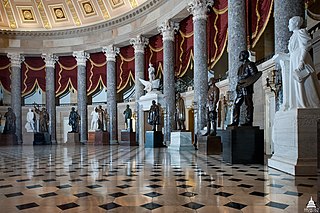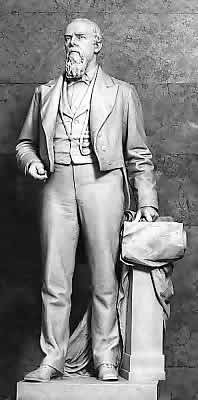
The National Statuary Hall is a chamber in the United States Capitol devoted to sculptures of prominent Americans. The hall, also known as the Old Hall of the House, is a large, two-story, semicircular room with a second story gallery along the curved perimeter. It is located immediately south of the Rotunda. The meeting place of the U.S. House of Representatives for nearly 50 years (1807–1857), after a few years of disuse it was repurposed as a statuary hall in 1864; this is when the National Statuary Hall Collection was established. By 1933, the collection had outgrown this single room, and a number of statues are placed elsewhere within the Capitol.

Jo Davidson was an American sculptor. Although he specialized in realistic, intense portrait busts, Davidson did not require his subjects to formally pose for him; rather, he observed and spoke with them. He worked primarily with clay, while the final products were typically cast in terra-cotta or bronze, or carved from marble.

The Father Damien Statue, also called the Saint Damien of Molokaʻi Statue, is the centerpiece of the entrance to the Hawaiʻi State Capitol and the Hawaiʻi State Legislature in Honolulu, Hawaiʻi. A second bronze cast is displayed in the National Statuary Hall Collection in the United States Capitol, along with the Kamehameha Statue. The landmark memorializes the famous Hawaiʻi Catholic Church priest from Belgium who sacrificed his life for the lepers of the island of Molokaʻi. Father Damien is considered one of the preeminent heroes of Hawaiʻi, and was canonized by Pope Benedict XVI on October 11, 2009. Cast in bronze, the statue depicts Father Damien in his later years after being diagnosed with the disease of those he attended. Much attention was given to the recreation of the disfiguring scars on the priest's face and his arm hanging from a sling.

Stephen F. Austin is a statue of Stephen F. Austin by Elisabet Ney, originally modeled in 1893 and installed in 1905; it is part of the National Statuary Hall Collection in the United States Capitol in Washington, D.C., as one of the two statues from Texas. The other Texas statue, Sam Houston, is also by Ney and was produced in parallel. Another carving of Stephen F. Austin is displayed in the Texas State Capitol, where it was installed in 1903.

Sam Houston is a statue of Sam Houston by Elisabet Ney, originally modeled in 1892 and installed in 1905; it is part of the National Statuary Hall Collection in the United States Capitol in Washington, D.C., as one of the two statues from Texas. The other Texas statue, Stephen F. Austin, is also by Ney and was produced in parallel. Another carving of Sam Houston is displayed in the Texas State Capitol, where it was installed in 1903.

James Paul Clarke is a marble sculpture depicting the American politician of the same name by Pompeo Coppini, installed in the United States Capitol's National Statuary Hall Collection, in Washington, D.C., as one of two statues gifted by the U.S. state of Arkansas. The 6 foot 10 inch tall statue was placed in the Hall in 1921. The work cost $7,500. and was unveiled in Washington in 1921.

Henry Clay is a 1929 bronze sculpture by Charles Henry Niehaus depicting the lawyer and politician Henry Clay, installed in the United States Capitol in Washington D.C. as part of the National Statuary Hall Collection. It is one of two statues donated by the state of Kentucky. The statue was accepted into the collection by Virgil Chapman on March 3, 1929.

John M. Clayton is a 1934 marble sculpture depicting the American lawyer and politician of the same name by Bryant Baker, installed in the United States Capitol, in Washington D.C., as part of the National Statuary Hall Collection. It is one of two statues donated by the state of Delaware The statue was accepted in the collection by Robert G. Houston on June 6, 1934.

George Clinton is an 1873 bronze sculpture depicting the American soldier and statesman of the same name by Henry Kirke Brown, installed in the United States Capitol, in Washington D.C., as part of the National Statuary Hall Collection. It is one of two statues donated by the U.S. state of New York. The statue is one of three by Brown in the Collection.
Huey Long is a 1941 bronze sculpture of Huey Long by Charles Keck, installed in the United States Capitol, in Washington, D.C., as part of the National Statuary Hall Collection. It is one of two statues donated by the state of Louisiana.

Philip Kearny is an 1888 bronze sculpture of Philip Kearny by Henry Kirke Brown, installed in the United States Capitol, in Washington, D.C., as part of the National Statuary Hall Collection. It is one of two statues donated by the state of New Jersey.

Robert M. La Follette Sr. is a 1929 marble sculpture of Robert M. La Follette by Jo Davidson, installed in the United States Capitol, in Washington, D.C., as part of the National Statuary Hall Collection. It is one of two statues donated by the state of Wisconsin. The statue was accepted in the collection by Senator John J. Blaine on April 25, 1929.

Robert R. Livingston is an 1875 bronze sculpture of Robert R. Livingston, one of the Founding Fathers of the United States, executed by the New York born sculptor Erastus Dow Palmer. The state is installed in the United States Capitol, in Washington, D.C., as part of the National Statuary Hall Collection. It is one of two statues donated by the state of New York.

Jacques Marquette is a statue by Gaetano Trentanove of Jacques Marquette, the best-known version being the 1896 marble one installed in the National Statuary Hall Collection in the Capitol in Washington D.C.

Oliver P. Morton is a 1900 marble statue of Governor Oliver P. Morton by Charles Henry Niehaus installed in the United States Capitol, in Washington, D.C., as part of the National Statuary Hall Collection. It is one of two statues donated by the state of Indiana. The statue was accepted into the collection on April 14, 1900, by Indiana Senator Albert J. Beveridge.,

Julius Sterling Morton, also known as J. Sterling Morton, is a 1937 bronze sculpture of Julius Sterling Morton by Rudulph Evans, installed in the United States Capitol Visitor Center, in Washington, D.C., as part of the National Statuary Hall Collection. It is one of two statues donated by the state of Nebraska. The sculpture was accepted into the collection by Congressman Karl Stefan of Nebraska on April 27, 1937.
Francis Harrison Pierpont is a 1910 marble sculpture of Francis Harrison Pierpont by Franklin Simmons installed in the United States Capitol, in Washington, D.C., as part of the National Statuary Hall Collection. It is one of two statues donated by the state of West Virginia. The sculpture was unveiled by the Hon. Thomas Condit Miller, on April 27, 1937.

Roger Williams is an 1872 marble sculpture of Roger Williams by Franklin Simmons, installed in the United States Capitol, in Washington, D.C., as part of the National Statuary Hall Collection. It is one of two statues donated by the state of Rhode Island. The sculpture was unveiled by Senator William Sprague of Rhode Island on January 9, 1872.

Roger Sherman is an 1872 marble sculpture of Roger Sherman by Chauncey Ives, installed in the United States Capitol, in Washington, D.C., as part of the National Statuary Hall Collection. It is one of two statues donated by the state of Connecticut. The sculpture was unveiled by Senator Orris Sanford Ferry of Connecticut on March 8, 1872.

Jonathan Trumbull is an 1872 marble sculpture of Jonathan Trumbull by Chauncey Ives, installed in the United States Capitol, in Washington, D.C., as part of the National Statuary Hall Collection. It is one of two statues donated by the state of Connecticut. The sculpture was unveiled by Senator William Alfred Buckingham of Connecticut on March 8, 1872.


















